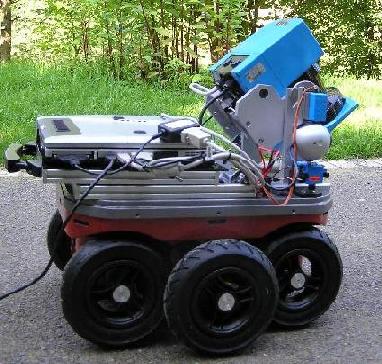
 |
Institute of Computer Science — Knowledge-Based Systems Research Group |
Practical Course "Kurt's Grand Challenge - Autonomous Driving in the Botanical Garden" SS 2006 |
| Lecture No.: | 6.762 |
| Faculty: | Prof.Dr. Joachim Hertzberg, Dipl.-Inform. Andreas Nüchter, Dipl.-Inform. Kai Lingemann |
| Appointed Time: |
weekly meetings are arranged with participating students |
| Room: | 31/508-09, Botanical Garden |
| Kick-Off Meeting: | ???, Room 31/505. |
| Examination: | Regular presentations about the work; final presentation; documentation |
| ECTS-Points: | 9 or 12 (requiring an additional oral exam) per semester |
| Prerequisites: | Informatik A, Basic Math, Interest in Robotics and Programming |
| available slots: | max. 12 |
TopicThe problem to solve during this project is this: One of our Kurt- type robots, which is equipped with a GPS receiver, is given GPS coordinates originating from approximate positions on paths in UOS's Botanical Garden. Relying exclusively on its on-board sensors and processing, the robot is then supposed to drive autonomously through the Botanical Garden from one GPS waypoint to the next, staying on the paths under all circumstances. There is no explicit time limit for finishing the task, but everything must be done within the capacity of one battery pack. The term "Grand Challenge" is borrowed from a recent competition (http://www.grandchallenge.org/) that featured autonomous driving over a course of 131.6 miles through the Mojave Desert. The scientific and practical challenge for the study project is somewhat less ambitious (and we don't have a budget for the price money of 2 Mio USD!), but it shares some spirit with the original. The point of the original Challenge as well as of related recent competitions like RoboCup is to advance science and technology together by posing very practical, easily communicable problems whose solutions require to go beyond the state of the art in some scientific respects. Our study project is a bit less demanding here, as its primary goal is education. However, if the students should manage to solve the problem completely, they can be expected to go right at the edge of the state of the art in mobile robotics in a number of techniques. |  |
The key scientific and technical problem to solve here is the on-line recognition of pathways, which are typically gravel paths in the Botanical Garden, but natural cobblestone is also present. The main sensors for recognition are a 2D laser scanner mounted at an angle scanning in front, and cameras. For image processing, natural lighting has to be used. The robot is supposed to work at dry weather only, but lighting conditions are sure to vary dramatically over different weather, sun angle, clouds, vegetation status, and positions (under trees vs. open area). In addition to that key problem, a number of other technical details need to be solved in order to allow the robot to drive autonomously over a relatively long distance in outdoor terrain (collision avoidance, speed control, intermediate target selection etc.). The existing control and sensor interpretation software on the Kurt robots may of course be used for the purpose, as far as it is applicable and helpful in this setting.
The project is suitable as a study project for Cognitive Science Master students (Master semesters No. 2 and 3), but it is also open for graduate students doing other studies. The contents and general organization are identical for students of both groups, but some formal details regarding the ECTS credits vary:
| Last changed: Feb 13, 2006 |